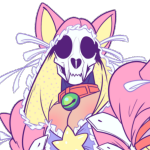|
Loxbourne posted:Storm of Chaos was an utter disaster of a global campaign. GW expected a proto-End Times from their players with the world getting trashed and dozens of named characters being slaughtered by Archaeon. It didn't work out that way at all, and 1d4chan has the lowdown. I know, what I mean is I think he was supposed to die and get replaced by Huss and Valten, turning the Empire into much more of an Imperium of Man style screaming theocracy. Him, specifically, living while the Skaven players managed to off Valten as a last spite stab (good job, Snikch) really threw off GW's plans for a potential Good Guy win, I think.
|
|
|
|

|
| # ? Apr 19, 2024 10:47 |
|
That's an interesting theory and would make quite a lot of sense out of the stuff being built up in the fluff. Although I suspect the scenario they were hoping for was the Empire getting trashed and Karl Franz dying in a last-ditch defence at Altdorf, stopping the horde after it had done a lot more damage. I know I bang on about the Storm of Chaos cockup, but understanding what GW were trying to do, how it went wrong, and how GW reacted with such angry petulance are crucial to making sense out of some of 2ndE's stranger backstory points.
|
|
|
|
Snikch, as a side note, is a terrifying blender of a Skaven who never gets the story respect he really deserves. Fuckin' tri-wielding Weeping Blades, man.
|
|
|
|
The setting would have been so much better if they had let Archeon stay dead, killed by Grimgor's hands, like the player results indicated. Then throw Chaos into a civil war to try to get a new everchosen.
|
|
|
|
Mors Rattus posted:Snikch, as a side note, is a terrifying blender of a Skaven who never gets the story respect he really deserves. Fuckin' tri-wielding Weeping Blades, man. I've always liked to imagine him as the only totally loyal rat in all of the Under-Empire. Like a rat Agent 47. He just wants to do his job and kill people, either in blender mode or various creative ways. No ambitions to rule or anything. Meanwhile, everyone he ever deals with is loving terrified of him because they cannot conceive of such a thing. This is in the absence of any real official characterization.
|
|
|
|
Night10194 posted:I've always liked to imagine him as the only totally loyal rat in all of the Under-Empire. Like a rat Agent 47. He just wants to do his job and kill people, either in blender mode or various creative ways. No ambitions to rule or anything. Total Warhammer 2 is for you. Queek Headtaker is being portrayed in the same vein.
|
|
|
|
All that the player participation in Storm of Chaos did was push a percentage win/loss bar on the GW website backwards and forwards. It went a bit wrong in that the results were pretty consistently 60/40 in favor of the defenders, but people are fantasizing if they think it had any effect on the fluff that got published. There was definitely no mechanism that would let player results dictate which characters lived and which died.
ZeusJupitar fucked around with this message at 15:29 on Sep 16, 2017 |
|
|
|
Warhammer Fantasy: Realm of the Ice Queen Praag did not die Praag is the cursed city for Kislev, much like Sylvannia for the Empire and Mousillon for Bretonnia. Praag is the furthest north major city in any of the sane human realms, located near the World's Edge Mountains and thriving on being at the end of the Warhams equivalent of the Silk Road. It is one of the major gateways by which the dwarfs of the World's Edge used to trade with people, and one of the only places in the setting you'll routinely find goods from Cathay, Ind, or Nippon (yes, I know, the names). Praag has also always been a center of Ungol nationalism, considered 'their' city, as it keeps alive their ancient traditions, crafting, and art forms. The exotic materials and crafts led to Praag being the place to go for artistic and imaginative souls, and as the city grew rich and famous, it produced some of the greatest Kislevite art, poetry, and literature. Praag was also famous for its hedge wizards and strange magics, being far from the Gospodar dominated lands and thus less under the thumb of the Ice Witches. Before the Colleges of Magic came to Altdorf Praag was where human mages who wanted to learn but didn't want to dive head-first into Chaos would go, and its beautiful onion domes used to be rocked by the occasional crazy magical explosion. Its people guarded their walls and fought against the raiders from the North, occasionally losing their city to a sack, but always coming back to rebuild better and stronger than before. What happened to Praag in 2302 is one of the reasons I say Asuvar Kul was a very thorough man. The city held out for months against the entire incursion, and without Praag's heroic defense the forces of the Empire likely wouldn't have had time to get things together and meet the enemy at Kislev. But when it fell, Kul tried his best to make sure it would not come back, this time. All of Praag was reduced to a complete nightmare as the Chaos forces spent weeks sewing corruption and slaughtering anyone who couldn't escape the city. Entire buildings became demonic flesh rather than stone, streets wept with blood, and in a very real way he tried to make Praag into a part of the Chaos Wastes rather than the sane world of the south. With the entire city turned into a pulsing vision of living stone and demonic ruin, most people would've abandoned it. When Kul was defeated, the Kislevites destroyed the demons and burned the infestation, sealed off the most salvageable parts with new gates and walls within the city, and began to rebuild. Praag refused to die. It took a century before they could coax the birds back into the skies around the city, and reduce the mutation rate below one in third, but the people of Praag rebuilt. Archaon struck them another blow as the walls were torn down in the Storm, but his haste meant he could not repeat Kul's earnest attempt to turn the city into Hell. The damage has only compounded the strangeness and gloom of the city, but it still hasn't killed it. Food and medicine are brought from the south, as the rest of the country refuses to let Praag die, either. Soldiers fight back the occasional demonic incursion. Traders from Cathay return to the great road. The silversmiths and artists build again, even if the dreams of the city have darkened a little. The great opera of Praag has reopened its doors, and the city continues to inspire poets and writers, even if the stories are sadder than before. The nobles throw great parties to remind people of how things used to be, while the Shallyan sisters fight a heroic battle against plague and mutation. The people of Praag know their home is wounded, and cursed, and has known true horror. They are prepared to die with it if they must, because it is still their city, and they will not let it go quietly. Next: The districts.
|
|
|
|
It’s time for another portion of: Warhammer Fantasy Roleplay: Children of the Horned Rat This time we’ll be going into Skaven culture. We’ve already covered the basics of their impulses and behavior, but we need to go into the more ‘refined’ parts of their culture. We’ll also be touching on their government and the clan structure they’re organized into. The Skaven language is called Queekish. It’s a sharp, chittering tongue, shaped by the people that speak it. Skaven speak very rapidly, generally speaking in hurriedly spat out sentence fragments as they try to speak as fast they think. In addition, they will repeat words for emphasis and join words together, using compound words for more advanced concepts. Non-skaven are always referred to as ‘things.’ This leads to charming lines such as “Die-die, dwarf-thing!” and “Dead-things! Hide-cower!” Skaven are quite capable linguists and can learn other languages readily, though their habits of repetition and fast talking color their language. Queekish has a written form, consisting of several thousand rune-esque pictograms. Most Skaven know a few of the most common pictograms, often used for signs and clan affiliation. True literacy is rarer. The pictograms are typically carved into wax or clay with a stylus or sharpened claw, though ink and paper has become much more popular amongst Skaven scholars, such as Grey Seers, Master Moulders, and Warlock Engineers. But language isn’t the only way Skaven communicate. They have a well-developed sense of smell and can use musks to communicate their emotional states. While typically involuntary, most Skaven learn to control showing their emotions this way to some extent. Both convey the emotions they wish to convey and to conceal their true feelings. To other peoples, the Skaven just stink of urine and dampness. The most common of these are the Musk of Battle, which can rouse a Skaven population into fighting spirit, and the Musk of Fear, which a Skaven excretes to indicate fear and that things have gone horribly wrong and that this would be an excellent time to flee in terror. Which other Skaven are often keen to do. The Musk of Fear is the most common musk excreted, leading to many a rout of clanrats and others, frustrating many a warlord’s plan. Oddly, now the book off onto a slight tangent to discuss drugs and warpstone. Recreational drug use is pretty common to Skaven life, it being one of the few pleasures they can get routinely. While some have actual medical or performance enhancing uses, most tend to be euphoria inducing narcotics of one type or another. Some of these drugs include warpstone mixed in, which vastly increases their potency while also vastly increasing their price. Also, long-term use of warpstone drugs can induce mutations in skaven. Other Skaven view these kinds of mutations with a mixture of awe and contempt, for only the most powerful rungs of Skaven society can afford to get blitzed so hard they mutate. We'll be going into warpstone and its gameplay effects a little later, but Skaven can and will use it in almost anything, from drugs to machinery to forging steel. They want warpstone more than anything. The next section is a charming list of common skaven customs one can see them engaging in routinely.
Ah, yes. The Grey Seers. The Order of the Grey Seers is the official priestly class of skavendom. They are not only ordained, but are actually something of a subspecies of Skaven. Every newborn skaven born with light fur and the nubs of beginning horns is whisked away by the Order to be raised and taught by their own kind, for they have been marked by the Horned Rat and carry great natural affinity for magic. Not many survive, as their fellow students and new teachers are as ruthless and treacherous as any other Skaven. The Grey Seers are more than happy to use their prominent place in Skaven culture to further their own ends and power, happy to throw out charges of heresy against those that displease them and frying messengers that bring bad news with warp lightning. Of course, they see themselves as bringing unity and the word of their god to the children of the Horned Rat. But they are happy to compete and intrigue against each other and using other skaven as pawns against one another. This is not a one way street, though. Many Warlords try their hands at manipulating the Grey Seers in return. And more than one troublesome priest has met a poisoned dagger in the dark. Most Grey Seers that survive into being a full priest have learned the art of discretion and know how far they can push their luck while still mustering the authority of their position. One plot point simmering in the background in Skaven culture is the religious strife between the Grey Seers and Clan Pestilens, both claiming to be the true voice of the Horned Rat. They hate each other intensely and see each other as a grave and continuous threat. They are both right, of course. These religious differences aren't exactly spelled out in one place in the book so this is a good place to bring it up. Grey Seers are the "mainstream" version of the Horned Rat, focusing on a wide variety of precepts and sorcery. These include Skaven domination, intrigue, planning, backstabbing, decay, and undermining their foes. The Grey Seers will lead their people in the Great Ascendancy as they claim the world the Horned Rat has given them. Clan Pestilens is much more focused. They also claim to speak for the Horned Rat and that the Horned Rat says "PLAGUE EVERYTHING". They are fanatical rather than discrete, they use their own bodies as harbors of infection, and are quite happy to die for the cause. Also, the leader of Clan Pestilens is named Nurglitch. Most other Skaven see them as more than a little insane, but are no keener on dying of plague than anyone else. The Grey Seers see them as dangerous heretics seeking to corrupt the true faith with this constant plague thing and are pretty sure they are worshipping something that isn't the Horned Rat. Politics and a desire to not have to deal with yet another giant civil war keep both sides from trying to settle their differences. Next: The Council and the Clans
|
|
|
|
Cythereal posted:Total Warhammer 2 is for you. Queek Headtaker is being portrayed in the same vein. Queek's another cool Skaven character. Really, most of the non-Thanquol Skaven named characters get short shrift, story-wise. Even Ikit Claw, who is loving amazing design. Ikit Claw is a cyborg skaven inventor who leads Clan Skryre in battle. He has horribly destroyed his own body with his experiments, so his face is replaced by a large metal plate, he's attached a giant warp-flux engine to his back, and he's attached to his namesake - a replacement left arm that ends in a giant, warpstone-tipped claw that has a warp-flamethrower mounted in the palm. He's also got huge resistance to magic because his engine tends to eat it.
|
|
|
|
There are many good rats, but the best ones ride giant hamster wheels with laser cannons and little racing flags.
|
|
|
|
Night10194 posted:There are many good rats, but the best ones ride giant hamster wheels with laser cannons and little racing flags. I'm partial to the ones who got so horribly murdered by lizardmen an entire god arose whose portfolio is "Kill Skaven."
|
|
|
|
Guide to Glorantha: Sun and Moon The Pelorians, also known as the Solar people, are quite ancient. In the Gods Age, they were ruled over by the sun god Yelm and his son Murharzarm, the first Emperor of Dara Happa. While the Dara Happan line was removed from power during the Dawn Age, they reestablished themselves quickly. Since 1250, the Pelorians have been ruled over by the Red Emperor, and they are the center of the Lunar Empire. Pelorians tend to be light-skinned, with brown or blonde hair and brown or blue eyes. Men have heavy beards but trimmed moustaches, except the Lunar cult, who tend to be clean-shaven. Women wear elaborate braids. The Pelorian culture is split into two broad types. The areas around the river cities are Dara Happan, while those in the rural areas are Lodrilli, and are seen to be less exalted and more watered-down. The Dara Happans are the inheritors of the culture of Yelm and the Solar Empire. Yelm made their laws and rules, and they follow these even now. The Dara Happans are a highly urban people with strong magical traditions, and can be found across the Lunar Empire, generally in leadership positions outside the Oslir River basin. The Lodrilli are rural farmers, primarily worshippers of Lodril and other agricultural gods, and have been ruled over by many in their long history, from trolls to Orlanthi. While the Dara Happans think of them as farmers exclusively, the Lodrilli have several urban subcultural traditions. In the western parts of the Lunar Empire, they tend to be ruled over by the Carmanians, a ruling class of soldiers and sorcerers derived from Western and Theyalan stock. The Dara Happans consider the city to be the only proper place to live. Yelm built the first cities and chose them as the first citizens. Trade is a special gift of Yelm's, and to most Dara Happans, village life is simply a source of comedy material. Anyone outside a city's walls is worth laughing at, even if they are Dara Happan by blood. They favor stone and brick, especially in large, pyramidal towers, and their cities favor a concentric, symmetrical design with radiating main roads out from the city center, where the temples are. Lodrilli, on the other hand, tend to be content to live as village farmers, growing maize and rice and raising livestock with simple farming tools and mud-brick huts. Most Lodrilli 'cities' are just big villages that are controlled by foreigners rather than Lodrilli - all Lodrilli cities are ruled over by someone else, whether Dara Happan or not, and typically are controlled by trade guild councils. Pelorian society is heavily stratified. At the top is the Red Emperor and his family, who are considered living gods. Under them are the Dara Happan nobles, descended from Yelm. Only they can hold certain priestly and leadership roles, and most of them are from a few dozen ranking families with ties to the Lunar government. Below them are the Witnesses and Officers, lesser aristocratic priests and military officers who hold substantial social rank. Under them are the Headmen - village leaders, merchants, soldiers and craftsmen, considered 'half-citizens' and forbidden to become full Dara Happan citizens. Under them are the workers, who provide most of the manual labor - diggers, carpenters, potters, pit bosses, that kind of thing. At the bottom are the Slaves, mostly agricultural workers and quite common in the Pelorian Bowl. They are captured in war, punished for rebelling against the Emperor or taken for a community's failure to pay taxes. Dara Happans are a patriarchal culture, tracing descent to a common male ancestor. Anyone born to Dara Happan parents in a Dara Happan city is a Dara Happan, with women considered necessary but socially inferior. Lodrilli families, on the other hand, are based on direct blood and marriage ties rather than shared ancestry, with familial ties going in descending importance out to six ranks of cousins and in-laws, and success within the culture is largely based on one's number of dependents. Lodrilli rarely travel at all, and respect age very highly. In either case, women are given a chance for social power if they join the Lunar cult, gaining Imperial patronage and protection. The Red Emperor is the supreme ruler of Peloria, the divine child of the Red Goddess and responsible for maintaining her earthly empire. Leaders of conquered states and Lunar religious groups report directly to him. Dara Happans consider it sacreligious to oppose or even criticize the Emperor. The Lunar Empire is divided into a number of satrapies, overlaid on the trade network of cities and towns. The tax collectors head out from the cities to each village in the satrapy, collecting trade goods and food to pay to the government. The most important Dara Happan cities are the triple cities of Alkoth, Raibanth and Yuthuppa, along with the 'new' Lunar city of Glamour. Lodrilli villages surround these, generally made of two to five extended families that are often interrelated. Villages rely on special bodies of witnesses and judges to oversee their social affairs and sharing of goods, and generally rely on their local priest or priestess to speak to outsiders. Pelorian culture values obedience over all other things. Rebellion against authority is a terrible sin, and even Chaos is seen merely as another form of rebellion against the divine order. All that the lower classes must do is obey orders. The upper classes are expected to pursue honor and justice. Honor means caring for those of lower rank and upholding one's noble duties and responsibilities. Justice means upholding the will of Yelm and is ultimately the duty of the Emperor. Among Dara Happans, gender division is extreme and rigidly patriarchal. Women are chattel. Sons outvalue daughters, brothers outvalue wives and fathers outvalue mothers. Lodrilli are patriarchal in marriage, with wives joining the husband's house, but Lodrilli women have property rights, right to divorce and are considered to own half of all marriage gifts. Clothing for both sexes gets heavier and mroe ornate as class rises, and is strictly controlled by law based on neighborhood and occupation. There are an estimated 7.1 million Pelorians across the world.  Right: A Dara Happan hoplite. Left: A Lunar cultist from the province of Oraya. Due to its many invasions and conquests, Peloria speaks many languages. The official state language is New Pelorian, and all nobles and educated people are likely to speak that. It uses a script adapted from Dara Happan but heavily simplified, and many foreigners are afraid that both the script and spoken language contain secret philosophical messages of the Red Goddess. Dara Happan is the tongue of the solar religions, learned primarily by priests, Dara Happans and pedants. It uses a sacred alphabet made by the god Buserian, and most religious literature is written in it, though often with New Pelorian translations. The lowland Lodrilli of Peloria all have their own dialects by region, and while Lodrilli dialects may once have had their own written forms, generally adapted from Dara Happan, only New Pelorian script is commonly used these days. Pelorian law is derived from the God Time teachings of Yelm, and justice is seen to uphold Yelm's will, though in practice the Emperor delegates it to officials. The Emperor is a benevolent autocrat, allowing access to these officials to all subjects and thus protecting the weak. Pelorian law divides all people into one of three types: noble, half-citizen or slave. It relies heavily on written judgments as precedent, and is ruled by a principle of eye-for-an-eye punishment. Death is a common penalty for crimes of theft or worse, though it is still more common for an official to assign fines. Peloria has not seen war in its heartland for over a century, and it is protected by the professional army of the Lunar Empire, which spends most of its time fighting in Dragon Pass, Prax and the Holy Country. The Dara Happans are well known for their heavy infantry and their cavalry. Pelorians typically follow the Solar pantheon, focusing on Yelm and his family, as well as the Red Goddess. All other faiths are seen, at least by Dara Happans, as aberrant and misguided. Yelm is the Emperor and Sun God, the authority which all others follow. The Red Goddess is the Goddess of the Red Moon, cycles and the Lunar Way - a mystical path of paradox and joined opposites. Other gods include Shargash, the primal war god and god of destruction, Biselenslib, the Long-Legged Goddess and wife to either Shargash or his son Alkor and mother of the river people, Buserian, the God of Priests, Writers, SCribes, Stargazing and Divination, Dayzatar, the God of the Sky, Purity and Moral Dignity, Lodril, the God of the Earth and Lower Worlds, Lokarnos, the God of the Slow Planet, Money and Counting, Oria, the Mother Goddess, Earth Goddess and Woman's Goddess, Oslira the River Goddess, Polaris, the God of Armies, Leader of Battles, and General of the War Gods, the Seven Mothers who restored the Red Goddess, SurEnslib the Heron Goddess, Dendara the Good Wife, Entekos the Keeper of the Middle Air, Erissa the Healer, Gorgorma of the Two Mouths and Thilla, the Keeper of of the Earth. Cities also have their own city-gods which are all quite similar but for local color. Yuthippa's city-gods are Dayzatar and Herustana, Raibanth's are Raibamus and Oslira, and Alkoth's are Shargash and Biselensib. Ancestor worship is also common. Pelorians are a very practical people, religiously. They sacrifice to the gods for aid, and if a god does not help them, they quickly abandon that god for a new one. The Emperor is both a god and a religious leader, and even now he is required to perform certain annual sacrifices, though many of his religious roles have been given to others over the centuries of his rule. The priests once ran the Empire, but now the bureaucrats are more secular. However, all worship Yelm. The highest priesthood is made of those men who are qualified to sacrifice directly to Yelm - no more than a few hundred in all of Peloria. The Enverinus Priesthood, a hereditary noble class of priest, handle the Imperial government's religious rites across the Empire, heading into the masses to bring them divine gifts, and overseeing the Permitted Cults of the Empire - large, popular peasant organizations of worship. The Lodrilli farmer religion is usually known as the Lodril Cults, worshipping various heroes and petty gods. They come in many varieties with many myths, are largely illiterate due to the laws forbidding Lodrilli from learning to read, and divided into many variant sects worshipping Lodril and other gods in many aspects. Most Pelorians never formally initiate themselves into any god-cult, but do attend various holy days and partake in casual worship. In Old Carmania, worship of the god Idovanus is common, as he is the Highest God of the Carmanians and God of the Law and Goodness. Orlanth is seen as the Rebel God, chief of Yelm's enemies. Temples are common in Peloria, with many designs. Portions of the gods are believed to dwell in these temples. Yelm and his sons favor towering ziggurats, the greatest of which is Raibanth's massive Footstool of Yelm, 350 feet tall and home to the Imperial Throne. The Star Towers of Yuthuppa are famed as temples to Shargash, and Lodril is often enshrined in terraced ten-block pyramids. Next time: Slaves of Fonrit
|
|
|
|
   TRANSCRIPT Dear Reader, I’ve recently come into possession of an interesting book. It’s called De Profundis and appears to provide an outline for engaging in a sort of collaborative storytelling between several people via written correspondence. Its definitely a novel concept, one I did not expect to find in our modern age. I must confess that I approached the idea with hesitation, after all sending letters isn’t nearly as common as it once was. But it’s an entertaining endeavor that should be tried at least once as an adult. There are few experiences more exciting than opening a handwritten letter, not knowing it’s contents but understanding they are the result of time and effort, but I digress, back to the topic at hand. The book itself is an interesting read, being written as a series of letters similar to stories like Dracula or Frankenstein. An Epistolary if you’re familiar with the term. It draws primarily from the writings of an H.P Lovecraft as its main inspiration. My own familiarity with the topic is predominantly secondhand, gleaning tidbits and scraps from media inspired by his various writings. I understand it largely involves individuals coming into contact with beings and forces far beyond their understanding. Their minds and bodies are tested as they try to survive and understand the things that now assail them and haunt their dreams. Of course people can interpret it as they will but that is my understanding of the themes involved, or at least the themes that have made it something of a touchstone in our community. The game itself is described as a collaborative storytelling game and a psychodrama. I was unfamiliar with the term but it helpfully provided a definition. Many of the compelling aspects of the game come from the writer’s own internal conflicts. They write about their fear, their anxiety, their excitement at discovering something new about the world. There’s no game master to direct things, no dice to be rolled, none of the many trappings one might associate with a game. Instead it asks participants to open themselves up and let their ideas and imagination flow. These ideas join one another like tributaries of a mighty river, creating a story that winds through a landscape both familiar and alien. This format allows the participants to get a glimpse into the minds of the players and their characters as they write about their actions and feelings, the latter of which can be quite intimate. This actually makes it quite easy in getting people to join. There’s no monolithic rulebook you need to reference, no dice you need to purchase and you play at your own pace, writing when you can and entrusting the letter to the postal system. It is a creative exploration of characters and events as seen through the letters they send to their friends and associates. That seems to be the purpose at any rate. This marks the end of the Introduction. It’s an interesting read so far. It’s been a long time since I read a story in this format and I’m quite curious to see how it develops. I hope you continue to follow my letters and that they find you in good health. Farewell, Unzealous unzealous fucked around with this message at 01:07 on Sep 17, 2017 |
|
|
|
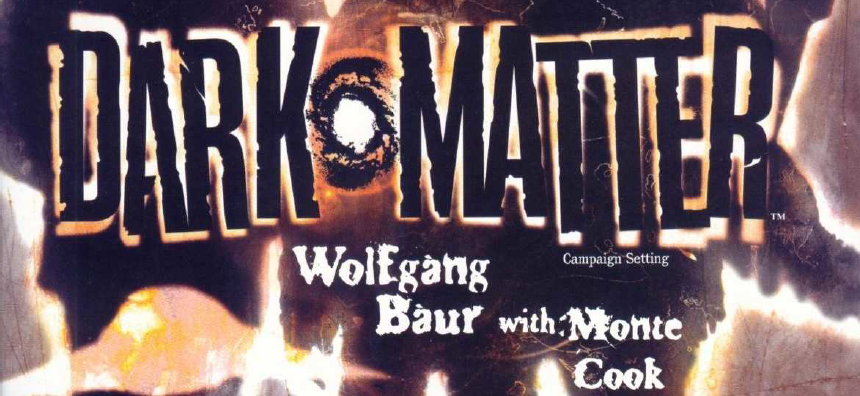 Chapter 3: Heroes of Dark*Matter 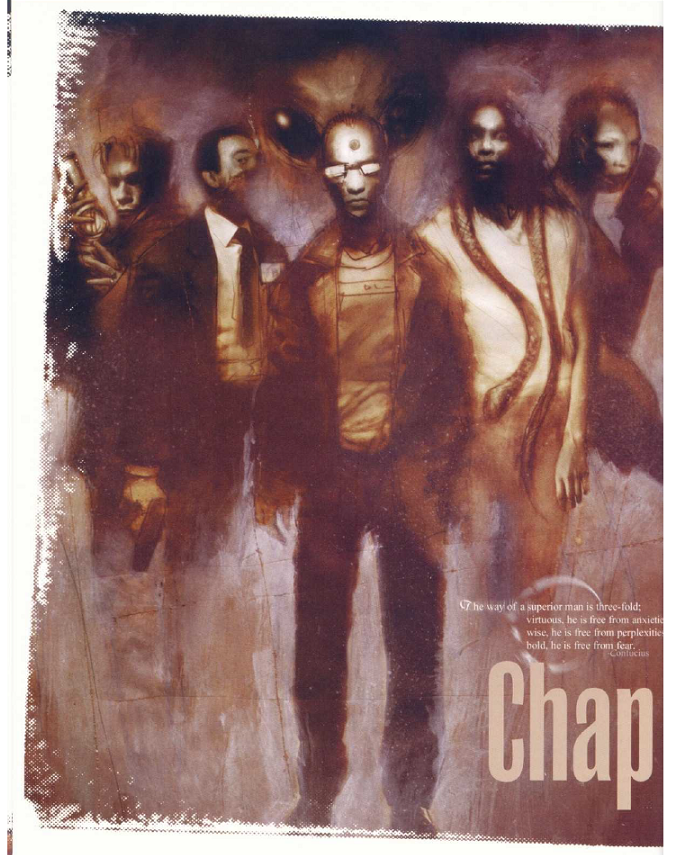 Chapter 3 is the standard Skills / Perks & Flaws / Careers / etc. chapter that is included in every campaign book that gives your players more options for character creation that are Alternity's conflict resolution system is Skill-based d20 roll-under. It also incorporates non-binary success and failure states; you can Fail or Succeed, and your Success can be Marginal, Orginary, Good, or Amazing. Circumstances that make your skill check easier or harder are assigned applicable Bonuses or Penalties, and the sum of all bonuses and penalties becomes your situation die modifier. The most un-intuitive part for new players is that Bonuses subtract from your roll and Penalties add to your roll, because this is a roll-under system which means golf rules apply. To attempt an action, you roll d20 +/- Situation Die. pre:Modifier Situation Die -------- ------------- +/- 5 +/- d12 +/- 4 +/- d10 +/- 3 +/- d8 +/- 2 +/- d6 +/- 1 +/- d4 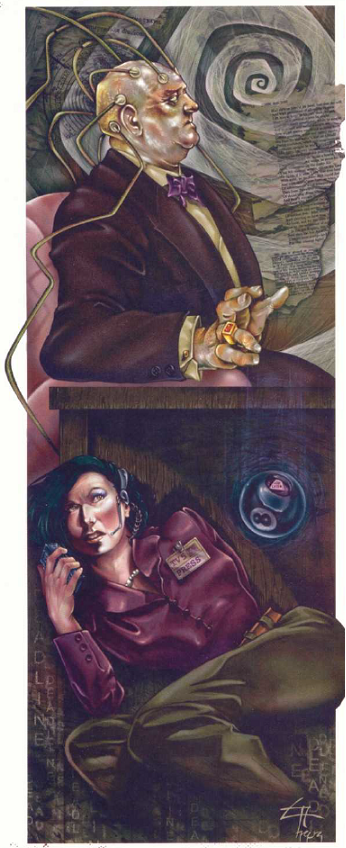 Most of the art for this chapter is paired with skill descriptions on the same page, and frequently my brain can't parse the connection. This is Creativity and Investigate? SKILLS: In order to determine whether or not you succeeded at doing a thing, you compare your final modified roll to your skill rank. Skill Rank can be two different sets of numbers, depending on whether you're using a Broad Skill or a Specialty Skill. Broad Skills are the generic skill umbrellas that cover basic knowledge about a thing (Ranged Weapons) and a skill check against a Broad Skill uses an Ordinary/Good/Amazing scale equal to Base Attribute / BA/2 / BA/4 (always dropping any decimals). You fail if your skill check result is greater than your Base Attribute. Specialty Skills are the specialized knowledge you have about a specific thing within a Broad Skill category (Ranged Weapons - Assault Rifles) and a skill check against a Specialty Skill adds your ranks in the Specialty skill to your Base Attribute before dividing, so a skill check against a Specialty Skill uses an Ordinary/Good/Amazing scale equal to Base Attribute + Rank / (BA+R)/2 / (BA+R)/4 (always dropping any decimals). You fail if your skill check result is greater than your Base Attribute + Rank. This means that you can buy multiple ranks of the same Specialty Skill to improve your odds of success, and many Specialty Skills also offer Rank Benefits past certain skill level thresholds. Rank Benefits have to be bought separately, meaning you don't get them automatically for passing the required Specialty Skill level threshold. You have to specifically buy the same rank again for the same cost, and they give your character some additional stunt they can do with the skill. Putting it all together, if your HI field agent has 10 Dexterity, the Ranged Weapons broad skill, and 2 ranks in the Assault Rifle specialty skill, to shoot your AR-15 at a feral mothman, you'd roll a d20 and your target numbers for Ordinary/Good/Amazing success would look like 12/6/3. If there was any Situation die, you'd roll that too and add or subtract that result from your d20 to get your final skill check score.  Look upon my bloat, ye mighty, and despair! So what's my beef with the system? 1. The full skill list (see above) is wayyyyyy too bloated and convoluted. It disproportionately favors Dexterity and Intelligence for the bulk of the skill sheet, meaning any character that doesn't invest in those two base attributes are objectively less effective (and hence less fun to play) than a character that does invest in those two base attributes. God stats ahoy! 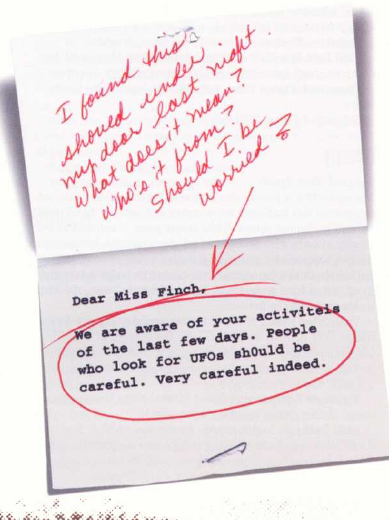 Journalism? 2. There's too many skills that have overlapping use, either RAW or RAI, and there's too many chances for a player to purchase the "worse" version of two nearly identical skills, Unless they're willing to memorize not only the literal skill definition for every possible Broad and Specialty Skill, but also possess encyclopedic knowledge of how each different monster or threat or hazard or obstacle interprets the skill list.
Why does the act of moving stealthily take three different skills? Why aren't Dexterity: Stealth - Hide and Dexterity: Stealth - Shadow and Dexterity: Stealth - Sneak just one single skill? Why are Intelligence: Computer Science - Programming and Intelligence: Knowledge - Computer Operations and Intelligence: Technical Science - Technical Knowledge three disparate entries? There's no commonality between these skills that might preclude just putting all of them into one skill? For that matter, what kind of information is too specific for Intelligence: Technical Science, to cover it, such that Intelligence: Technical Science - Technical Knowledge needs to exist to keep things from getting out of hand? Why does Intelligence: Technical Science get Invention but not Will: Creativity? Doesn't inventing things require some degree of creativity, and vice versa? Why does Personality: get 4 broad skills and 14 (!) Specialty Skills that are all just synonyms for verbally convincing to do something for you? Personality: Convince - Verbally could coexist along with Strength: Coerce - Physically and it'd make just as much sense and take up 1/7 the space.  Life Science and Medical Science? 3. Because of the aforementioned bloat there's a frustrating lack of consistency, even between Alternity designers, regarding which skills should be used for which purpose. Sometimes, even within the same adventure, you would have extremely similar situations that arbitrarily use two different skills to resolve them. Some examples:
What if I need to swim away from a shark that's trying to eat me in the ocean? Am I using Constitution: Movement - Swim because I intend to swim through the water, or am I using Constitution: Movement - Race because I am racing the shark to my boat/dry land/safety? What if I have to resist torture? Do I roll Constitution: Stamina - Resist Pain or Will: Resolve - Physical Resolve? When do I use Intelligence: Knowledge - Deduce versus Will: Awareness - Intuition? What is meaningfully different between these skills? 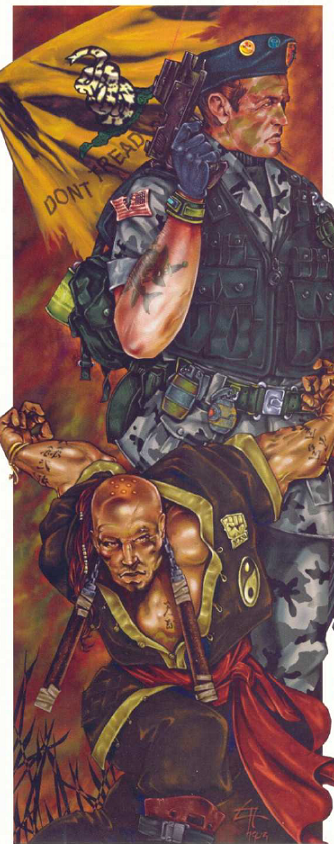 Militiaman? Maybe. Street Punk? Uhhhhh? 4. Rank Benefits are either completely underwhelming or gate off skill functionality that should really just come with the core Specialty skill. Rather than giving your character some extra, cool, unique thing to do, they're just the prototype for the D&D 3.X / Pathfinder school of design; Rank Benefits are used primarily to reduce or remove the penalties for trying to use your skill for something it should already cover.
Want to be able to dodge incoming gunfire and try to return a little heat yourself? Too bad! You can't both dodge an attack and take any other action until you've bought 3 ranks in Dexterity: Acrobatics - Dodge and then bought rank 3 again. You also can't declare that you're using your action to dodge an attack if it happens before your initiative until you've bought 7 ranks in Dexterity: Acrobatics - Dodge and then bought rank 7 again. What an interesting way to make sure low level combat is extra lethal! Want to draw your pistol and shoot it with the same action? You're going to get an action penalty for that, unless you have Dexterity: Ranged Weapon - Pistol at 3 ranks and you also bought rank 3 again. Want to use any other weapon in the same action that you drew it? LOL, buy up to rank 3, plus rank 3 again, for each type of weapon with which you might want to have this functionality. I don't even know if it would have been worse to just make Dexterity: Ranged Weapon - Quick Draw its own skill; on the one hand, skill bloat, but on the other, it's really silly to have to buy this specific Rank Benefit for EACH type of weapon you use. 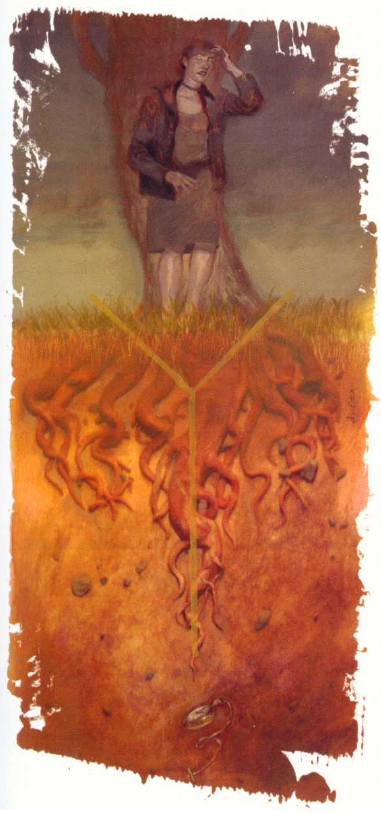 Investigate? PERKS & FLAWS: No surprises here; if you've seen one game's Perks & Flaws section, you've seen them all. Like every other game, these can be bought either at character creation or with experience points earned from advancement. Their practical use is to min/max some specific character concept with a bunch of drawbacks that contain an extremely fatal degree of punishment but are also miraculously paired with an exceedingly infrequent chance of ever coming up over the course of an adventure. You know, gaming the maximum number of points out of the character creation system. Most of these are pretty boring - get a minor bonus to this skill or take a penalty when this specific thing occurs, but I'll highlight a few that are notable: High Tech Your hero starts the campaign with one fully functional alien/futuristic/occult/etc. item or weapon. This is the D&D equivalent of starting a level 1 hero with a magic item of his/her choosing. The perk specifically says the item doesn't have any drawbacks or hidden penalties and will work flawlessly unless your hero gets a Critical Failure result on a skill check when using this item, whereupon it will break (Alternity does Critical Failures on any natural 20 rolled, so there's a 5% chance this will happen every time the item is used). All this for the low cost of 4 experience points, about the same as a broad skill or the first rank in a specialty skill; in other words, this is so cheap that there's literally no reason every starting hero shouldn't have this, and shouldn't be paying to replace it whenever their current magic item breaks. Networked A Perk with a vague mechanical explanation that grinds the game to a halt for everyone else while you resolve a game of Mother May I? with the GM. You gain a -1 bonus any time you use a contact or allegiance. How do you "use" a contact or allegiance?  There's no specific Allegiance Specialty Skill, and the only other mechanical use of the term Allegiance is for Alternity's version of alignment - essentially you have 3 descriptive phrases you can pick out for your character at creation (for example, you can be Brave, or be a Law Enforcement Official, or love Punk Rock Music), and when you're dealing with NPCs with similar Allegiance the GM is supposed to give you more favorable interactions. This gives you a -1 bonus on top of that (?) so I guess the GM has to somehow convey that your NPC interaction is going better-1. There's no specific Allegiance Specialty Skill, and the only other mechanical use of the term Allegiance is for Alternity's version of alignment - essentially you have 3 descriptive phrases you can pick out for your character at creation (for example, you can be Brave, or be a Law Enforcement Official, or love Punk Rock Music), and when you're dealing with NPCs with similar Allegiance the GM is supposed to give you more favorable interactions. This gives you a -1 bonus on top of that (?) so I guess the GM has to somehow convey that your NPC interaction is going better-1.Well Traveled Any time you visit a new location for the first time, you can try to "remember" an NPC that your character knows at this occult conspiracy/alien mothership/yeti sex dungeon/etc. by making a basic Personality check. Succeed, and you get to make up an NPC that offers you some kind of minimal assistance. Fail, and it turns out the person you remembered was a jilted ex-lover (or someone else you pissed off for some reason) and instead they're an additional obstacle for your team until you leave the area. Nothing like a perk that can also randomly penalize you! This is also something that seems like a good GM would just allow any player to do at any time following the rule-of-cool, but Alternity isn't one of those dirty story games. 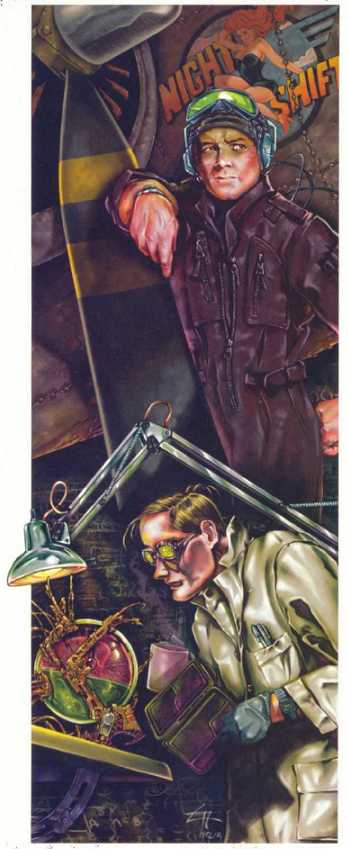 At least these two people could conceivably be a Field Guide and a Doctor. CAREERS Alternity has a vestigial class system with four very loosely defined classes (Combat Specialist, Diplomat, Free Agent, and Technical Operative) that provide some minor bonuses to a first level character and broadly impact how much certain skills cost to purchase. Since the base class system is so minimalist, the Careers section is basically several pages of imagination fuel for players that are having a hard time wrapping their heads around which skills they should use for a given character concept (because again, there's no mechanical difference between a Solider and a Police Officer and a Militiaman and a MMA World Champion - they're all fall under the same Combat Specialist class umbrella). Each career is just a short blurb about what that type of profession would be doing in a Dark*Matter campaign and includes a list of recommended skills and perks and flaws for a new character to buy. There's no mechanical benefit to being one type of Free Agent versus another type of Free Agent, so I'm not going to transcribe any of the suggested careers here. If you can imagine what kind of skills a Private Detective should buy, then you're already too competent too need this section. BOOM! Chapter 3 done! Next time we roll into Chapter 4, all of the occult mysteries that plague the world of Dark*Matter! This is somehow just another 20 pages of Broad Skills and Specialty Skills 
Freaking Crumbum fucked around with this message at 06:07 on Sep 17, 2017 |
|
|
|
If those skills include supernatural functionality, some of that art makes more sense, like that one lady using Investigate to dowse for a lost watch.
|
|
|
|
I have the first edition of this, and even played a game of it, although we didn't get far. Looking forward to the review!
|
|
|
|
Yeah I have De Profundis somewhere in my To Read pile after I got it from a bundle so I'm glad someone is interacting with it.
|
|
|
|
Dareon posted:If those skills include supernatural functionality, some of that art makes more sense, like that one lady using Investigate to dowse for a lost watch. that would be a pretty cool twist on an otherwise pointlessly bloated skill system! unfortunately, that would require way more creative thinking than Alternity is capable of handling. Investigate only includes mundane methods of finding out information. HOWEVER! There is a psychic power listed in the next chapter that does include finding missing objects via dowsing. This is gated behind yet another Broad Skill/Specialty Skill list and also incorporates elements of finite resource management, because nothing says good game design like multiple arbitrary hurdles to playing interesting characters!
|
|
|
|
Guide to Glorantha: The Blue Man Group The Fonritians, people of the city-states of Fonrit, are an ancient and wealthy people. Over a thousand years ago, a group of Agimori adventurers conquered and enslaved the local people. Slavery continues to define Fonritian culture, in which the rich and powerful ruthlessly tax the poor and force them into hard labor. The people of Fonrit have blue, black or white skin, in just about any combination. Most of the ruling class are dark-skinned Agimori peopel, while most of the lowest slaves are blue-skinned Veldang. Most of the population, known as Torabs, are mixed blue and black. Fonritian culture is based out of the Fonrit peninsula and nearby Laskal, but since the Opening of the Seas, Fonritian traders can be found in just about any port as well as raiding coastal villages for slaves. There are an estimated 10.1 million Fonritians or so, mostly in Fonrit proper. The Veldang are descended from the people of Artmal, who was a hero and son of the Blue Moon during the God Time. However, they were overly proud, and the storm gods defeated them during the Gods War. They were enslaved by Garangordos the Cruel during the Second Age and forced to worship him and his companions. The rest of Fonritian culture is based on where you come from. The Afadjanni are a network of city-states enslaved to the Jann of Afadjann, who allows great diversity of belief and culture. The cruelties of the upper classes are great, but the people are kept distracted by the internal conflict between the Renewed and the Oldsters. They are not, however, the most slave-domianted culture in Fonrit. That'd be the Kareeshtans of Kareeshtu, where everyone and everything is owned by someone else, who in turn belongs to someone else, and so on. The cities of Banamban and Baruling are just as cruel, but have more free people. The city of Thinokos predates the Gargandites and is a seafaring culture that claims to come from a mythical land known as Thinobutu. The areas of Marana and Tarahorn are largely dominated by nomadic shepherds and bandits. The area of Mondoro is very strange by Fonritian standards - one of its cities has a slave-king, another forbids entry to women and yet another has no slaves at all. Fonrit rediscovered civilization when they freed Ompalam from a Western demon, Jraktal the Tap. Garangordos and his companions, the Glorious Ones, brought this knowledge home with them - and chief among the lore that he brought was that people could be bought and sold and made to work. Slaves do all the farming in Fonrit - primarily slash-and-burn horticulture and the raising of goats, pigs and sheep. Crafters and artisans are semi-free, with far more rights than agricultural slaves. (Crafts include assassination, alchemy, bronzework, prostitution, priesthood, weaving and trading.) Every craft maintains its own organizations, god-cults and trade secrets. Craft guilds, secret societies and cults are vital to Fonritian life, and many organizations even own large parts of their membership.  Left: a Torab slave-soldier, treated better than most slaves. Right: A masarin sorcerer. Slavery is central to Fonritian society. There are nearly infinite grades of slave and free person. At the top is the city tyrant, known as the jann, who is slave only to the gods. Every tyrant is served by a small group of free nobles, the masarin, who own vast numbers of slaves but are not owned by people. (They can be owned by gods.) No more than 5% of the population is masarin. 5% of the population are slave-soldiers, the Fonritian military caste, are treated better than other slaves and kept segregated into barracks-communities. About 20% of the population are yad - slaves who can own slaves. They lack political or military rights, but are semi-free and can become fully legally free. About half the yad are skilled professionals or artisans, while the other half are petty landowners or stewards for the jann and masarin. The rest of Fonritian society is made of kaddam, the lowest kind of slave. They are chattel and have no rights whatsoever. Most pure blue-skinned people belong to the kaddam class. Among the free, there is a further split based on whether one's mother was of the tsanyano, or Renewed class or of the bolgaddi, or Oldster class. The Renewed tend to be more liberal, and often allow their slaves to marry or occasionally purchase their own freedom, as well as granting them limited religious choice. Oldsters are more ruthless on average, and believe that life is necessarily suffering and all must be judged harshly. Fonritian society holds that all life is slavery. The soul is the slave of the body, the powers and elements are slaves to the runes, the people are slaves to the ruler, the gods are slaves to Time. Slavery is the order of the universe, and it is right and good to submit. Outsiders often claim this is merely post-hoc justification for Fonritian cruelties. Fonritian households are patriarchal, but kinship and descent is matrilineal. Free women have all the same legal rights as men, and like all slaves, enslaved women have no more rights than their master gives them. Slave marriages are rarely given any legal protections, and slaves are at constant risk of being moved apart or sold off. Masarin marriage is usually polygamous, and ownership of male or female concubines in harems is very common. The free are notable for wearing flowing clothing with intricate decoration, veils (if women) and lots of jewelery. Slaves wear whatever their master gives them, and may wear jewelery if they have wealth of their own. This is especially true of temple slaves, who may have more wealth and power even than the masarin, based on their god's desires. Fonritian city-states are largely unaligned, but are dominated by the political confederations associated with the Jann of Afadjann, who wields the powers of the Glorious Ones as long as he remains ritually pure and demands tribute from lesser city-states, or Golden Kareeshtu, ruled by the immortal Archidomides, Vessel of Ikadz and Tondiji. At present, Golden Kareeshtu is moer powerful. In the Gods Age, the land of Fonrit was part of the Vadeli Empire of Chir, and Garangordos used the Vadeli magic to help liberate Ompalam. The Vadeli myths and traditions have permeated the land over time, warping the Fonritian culture into what it is today, a place where slaves are everywhere, Chaos magic is accepted, and mortal men or demons are worshipped as gods. The Vadeli returned to Fonrit when the Opening happened, conquering much of it in the guise of returned Glorious Ones, and were worshipped as gods, but were betrayed at Kareeshtu and defeated. However, every port has a Vadeli enclave still, where the Vadeli sell dark and terrible things - occult secrets, strange items. Most shun them, but their secrets always lure in a few. Many worry that they plan to secretly enslave all of Fonrit. There are four interrelated Fonritian languages. The original tongue of the blue-skinned natives is long dead, though it does still influence Mondoran, spoken in the Fonritian interior. It is only distantly related to the other languages. Afadjanni is spoken in and around Afadjann, while Banamban is spoken along the coast, and Kareeshtan is spoken by the people of Golden Kareeshtu. Fonritian has two written forms. Old Fonritian is pictograms and used primarily by priests for ritual texts these days. New Fonritian is based on Western symbols, but it is a syllabary rather than an alphabet and is used completely differently from Western languages. It is used for most purposes these days. Fonritian law is tyranny. City rulers can do whatever they like, to their own people or outsiders. However, Fonritians recognize the Garangrapha as a recording of sacred law, defining the nature and gradations of slavery and the rights of slave owners. Beyond this, all law is derived from the codes put forth by a city ruler. However, the thieves of Afadjann are notable for following the traditions set forth by the god Selarn in the Great Darkness, which define clearly and unbreakably the laws of thieves. They enforce these laws ruthlessly and have survived centuries of Fonritian rule, maintaining a strong streak of hostility towards the authorities. War is common in Fonrit, as the city-states battle each other incessantly, as well as everyone nearby. Every city has slave-soldiers, and most nobles keep bodyguards, generally foreign and free mercenaries paid quite well. They do not use cavalry much, save for a handful of war elephants kept by each city. Wars tend to revolve around sieges due to the heavily fortified nature of Fonritian cities. They also have skilled navies, most notably that of Kareeshtu. Fonrit has a very rich pantheon of gods and religions. The most potent cults tend to be state-supported, and the patron god of a city is always its most important one, even if that god is unknown anywhere else. Often, a jann is also worshipped as a living god. The priesthoods are inevitably quite corrupt and powerful politically. The most important god, generally, is Ompalam, God of Slavery and Coercion, who states that all life is slavery. Garangordos is worshipped as the Bringer of Civilization and Conqueror of Fonrit, and Guardian of Ompalam. Other major gods include Abamedric, the Man of Two Swords and a war god, Bendaluza, Lord of the Phallus and maker of cities, Darleester the Noose, the state god of Afadjann and the weapon wielded by Garangordos to enslave or kill the blue-skin people, El Jazuli, the Sister Witch, Ernamola, the Goddess of Millet, Gark, the God of Eternal Peace, Eternal Life and Undeath, the Hungry Goddess, ancient patron of the blue-skins, Ikadz, the God of Purification, Torturers and Burner of Evil, Seseine, the Goddess of Seduction and Lust, and Tondiji, the patron god of the city of Tondiji and worshipped nowhere else. Minor gods include Artmal the Slave, Baraku the Storm God (another name for Orlanth), Jokotu the Traitor and Murderer, the Invisible God, Malubadou the Beholder, Mandakusour the Spirit Binder, Serartamal the Blue Moon, Tadarida the Dead Goddess, Tentacule the High Slavery God, the Two Brothers of War (who are Humakt and Zorak Zoran) and Varama the Sun God. It is said that Garangordos gathered the Seventeen Glorious Ones on the Necklace of Life journey, and they released Ompalam and liberated Fonrit from Jraktal the Tap from the West, gaining many secrets. Each of the Glorious Ones returned with a benefit of civilization to give to their slaves, and so conquered the Veldang. Garangordos was murdered by his steward, Jokotu, but the other Glorious Ones slew the traitor and went on to found the original city-states and establish the masarin dynasties. Four of them took Garangordos' teachings, the Garangrapha, in each direction. When they died, they continued to be worshipped as gods. Fonritian religion is built on submission to the gods, with humans existing only to serve the gods. Devotion to a single god is in the hope that this god will favor such a loyal and obsequious slave. In most cults, the priests handle direct worship and sacrifice, using the rituals set forth in the Garangrapha. Slaves are often sacrificed at funerals, to certain gods or to magically empower the city ruler. It is believed that these slaves follow their master in the afterlife. It is common to make pacts with spirits and demons. Weaker spirits are enslaved, and stronger ones are masters, with the pacts made by the aid of a Mandakusour priest-shaman intermediary. Sorcery is common in Fonrit, and sorcerers seek to master the magical master-slave hierarchies of the Otherworld. A number of Malkioni heresies, often quite perverse, flourish in the area. Most notable are the Wool Cloaks, who seek total understanding via total submission to Ompalam and annihilation of the self while the body still lives. They claim this, paradoxically, makes them the most liberated in all the world. It is widely believed in Fonrit that the body must be preserved after death, so that the soul can reunite with it and take pleasure in the afterlife, leading to complex sarcophagi in which mummies are often magically preserved. An extreme offshoot believe the body must be preserved at all costs. The cult of Gark the Calm often donate their corpses to the temple of Garm, allowing them to be animated as laborers. Once their labor period ends, the corpse is supposedly sent off to the holy temples in the mountains. The cult gives amulets to the descendants of the dead, which will let them know if their ancestor slips away despite the tender ministries of the god of undeath. The gods are said to reside in their temples, and each temple is devoted only to one god and is their true dwelling place...even if the god has multiple temples. They are built to resemble massive homes, with apartments dedicated to the god and their dependents. The presence of the god is ensured by the cult statue, made of stone, bronze or gold, and decorated with gems and precious stones, often attended to by images or statues of slaves. The priests also live in the temple, to better serve the god. Most priests are slaves of the temple, though some are masarin or slave-soldiers. Next time: HE, ZZABUR
|
|
|
|
Oh man is it about to be Zzabur o' clock? Also, I think once I finish Kislev, I'll be doing the Official Campaign. It does a better job of getting across Imperial flavor than Sigmar's Heirs and some of the more baffling points need to be seen. It's not a huge trainwreck like Abandon All Hope, just features silly moments like the book assuming PCs might need twelve Imperial soldiers as backup to deal with a single Lesser Demon after throwing them through a gauntlet of full plate armored knights without help, or The Inexplicable Tzeentch Illuminati Metagame. Overall it's a fairly normal, if a little too Chaos focused, campaign that'll take a hapless group of a Bretonnian thief, an Imperial duelist, a Dwarven runesmith, a Kislevite peasant woman, and an Elven noble through three or so careers of trying to deal with demonic nonsense to defend the Empire.
|
|
|
|
Well, it's about to be the first of several Zzabur O'Clocks, this is the one where we talk about Western society and the legacy of HE, ZZABUR as opposed to the deeds of HE, ZZABUR
|
|
|
|
Oh, man, the Vadeli. In brief, Zzabur and his people are immortal as long as they follow the Law of their Caste. Leaders only Lead, Workers only Work, and so on. The Vadeli are descended from Zzabur's evil brother, Vadel. The literally remain immortal and become more powerful by doing evil to other people - that's their Caste's Law. The Vadeli compete with the worst of the Lunars for the title of Worst People in Glorantha.
|
|
|
|
The Vadeli and honestly Fonrit are worse than the Lunars, let's be real here.
|
|
|
|
Mr. Maltose posted:The Vadeli and honestly Fonrit are worse than the Lunars, let's be real here. Yeah I'll be honestly impressed at any society managing to be more evil than Slavery Is The Fundamental Law Of Reality Civ over there. Not really a good kind of impressed though.
|
|
|
|
They might be more right than you'd think, 'All Life Is Slavery' was Sheng Seleris's epiphany, and he found it from a very different context.
|
|
|
|
Counterpoint: When your position is also backed by Sheng Seleris it's time to really reflect if you're an rear end in a top hat because that's a good sign you're a real rear end in a top hat.
|
|
|
|
Sheng's fine, just because he's one half Genghis Khan and one half Antichrist and was so brutal he got his own Hell doesn't mean he has some good points about the cosmos and that the Lunars and Kralorians suck.
|
|
|
|
    TRANSCRIPT: Dear ReadeR, I find myself spending more time indoors as of late. A significant portion of my state is currently ablaze, filling the air with a smoky haze and irritating my olfactory to no end. On the bright side that does give me more time to talk about this intriguing book, especially now that I am past the introduction and into the meat of the contents. A key difference between this game and role playing games is you will always be writing from your character’s perspective. YOU are the character and you will write about what you do, how you feel, your hopes and dreams, the latter of which can be quite unpleasant. There is also the question of what world will you be playing in? Lovecraft, as inspiration for this endeavor, has a library filled with places, people and creatures but that is not the world you should play in. Instead, consider our own world, the one in which you and I reside. I’m sure you’ve seen strange things in your day to day. Odd things that made you curious, but could not be explored due to time or perhaps a lack of resources. But here in the game world you do have the time and the resources necessary. The game world is made up of our own reality, the themes of the unknown inspired by Mr. Lovecraft and similar authors, and our own ideas of what lies just beneath our reality. You and your associates will investigate, explore, encounter and decide what the truth is, and what it means to all of you. Of course I would not ask you to actually do what you write about. The police take a very dim view of those who trespass into abandoned buildings and do not take “Exploring the edges of reality” as a valid reason for doing so. Likewise striking someone because you believe them to be a member of an insidious cult would also require a substantial amount of evidence at the inevitable court appearance. Instead you will adopt a persona that you will write from. This could be a version of yourself, perhaps made a bit more mysterious and resourceful. It could be a character you’ve made before in a session of the roleplaying game Call of Cthulhu or perhaps a character from a Lovecraft novel. The choice is ultimately yours to make. It is recommended, however, you be at least a little knowledgeable in the field you claim to be an expert in. You do not want to be thoroughly debunked by a brief skim of an encyclopedia. Then the only character you’ll be playing is a prat, and no one wants that. Now, I had to ask myself at this point, “How many people should be in a game such as this?” Thankfully the book provided a few suggestions. You can have a small group of people who all know one another and exchange letters freely, which is what I believe most of us would begin with. There is also the option of forming a network, where anyone can join and there’s no limit to the participants. Everyone would be working together, writing stories that weave in and out of one another like a grand tapestry. While this does seem exciting it does mean sharing your address with a large amount of strangers which some could understandably find an uncomfortable breach of their privacy. With such a large group you will likely need individuals to function as moderators and organizers, making sure that the people are working off the same page, so to speak. The setting is also something I was intrigued with, as it can not only vary in place, but in time as well. If one is playing a game in the modern day it is recommended you write from a location you’re familiar with. It will sound more authentic as you speak of places you are intimately familiar with. It may even give you an excuse to go out and explore places you’ve never visited before, assuming such visits are legal. As before I do not condone any sort of trespassing for the purpose of the game. There is also the option of playing during the time of Lovecraft himself, the 1920’s. Playing then will give you more leeway in terms of inaccuracies as others are unlikely to be familiar with the century old version of places. It’s also mentioned here that it would be fairly easy to run a game that takes place in both times at once, where each participant has a character in each time period. It would allow the characters in the present to find and react to things accomplished in the past. The only caveat being that if this is attempted the outside of the envelopes should be marked in such a way that it is immediately apparent which time they are from. This will allow the reader time to obtain the necessary mindset and attitude before opening them. As for style I’m sure you are already well aware of what is generally expected in a letter, being an individual of class and refined tastes. Address the other party respectfully, unless you have obvious reason for not doing so. Make sure to introduce yourself if you have not done so already. You can also decide that your little band of investigators are already familiar with one another and reference events and letters of the past. For this game in particular it is important to date your letters so, if you wish to peruse them at a later date, they are easy to organize. I also found this interesting paragraph that I am copying verbatim as I hope you will find it as amusing as I did. “One more thing: email. No email! This will kill the atmosphere stone dead. Unless someone deliberately wants to play using a different convention from the other two, and create a vision of today’s world with its Internet, its hurrying around, cell phones, great rushing streams of information, exchanges of brief electronic messages full of verbal static, acronyms, computer slang and the like. This kind of thing would let them create a world straight out of Conspiracy Theory or The X-Files. But the ease and convenience which the Internet tempts us with are deceptive. If, through sheer laziness, using email prevents you from savouring the game in its traditional paper form, be careful: communicating and expressing one’s thoughts on paper is totally different from e-mail. A letter requires effort, takes your time, your concentration. It’s a sign of your respect for the addressee, too. Email is slapdash trash, full of mistakes, sometimes just tacking a few rushed comments on the end of thoughtlessly quoted fragments from a previous message. Let those who use email as their standard form of communication have a rest from their computers in the evenings when they’re playing De Profundis. Either way, be wary about email, as it distorts communication and our attitude to the addressee.” Unfortunately that’s all I feel like writing at the moment. Listening to the news caster constantly talk about the fires is almost as exhausting as breathing in these noxious fumes. You’d think they’d have the drat things under control by now. Do not worry for my safety, they are still hundreds of miles away and I am positive they will be controlled before long. FarewelL, Unzealous
|
|
|
|
Sheng learned that All Life is Slavery in the Dragon Empire though, and it was explicitly not the lesson they were trying to teach him. "maybe you should stop being such a dick to everyone and think of somebody other than yourself, also the pillage and murder is pretty bad" "NO ALL LIFE IS SLAVERY I MUST ENSLAVE THE WORLD"
|
|
|
|
That's exactly why it must be right, he meditates for ages and comes to the same conclusion as an ancient empire across the world, despite the differences in circumstances, and then became absurdly powerful. Plus there's the societies that become immortal by doing what they're told, like the Mostali. That shows there's gotta be something there. Shang Seleris 2020
|
|
|
|
unzealous posted:
quote:I also found this interesting paragraph that I am copying verbatim as I hope you will find it as amusing as I did. Does the book come with a free fedora, or is that a supplement you have to buy?
|
|
|
|
wiegieman posted:Sheng learned that All Life is Slavery in the Dragon Empire though, and it was explicitly not the lesson they were trying to teach him. If all life is slavery, isn't the world enslaved already? Like, dude. A fish campaigning against dryness in the Marianas trench is a loving lunatic, you know? Maybe pick something else to deal with. Like... hunger. Maybe the world is all enslaved, but also some parts are enslaved and hungry, so why not get the poor hungry people some BLTs so they can better cope with the slavery that's more or less inevitable according to your worldview?
|
|
|
|
Also, calling Mostali and Zzaburi slaves would be inaccurate at best. No one owns them. They're immortal because they don't break kayfabe and Know Their Role.
|
|
|
|
chiasaur11 posted:If all life is slavery, isn't the world enslaved already? Well, Sheng was crazy. That's what happens when you try to use a century of ascetic deprivation to mystically enlighten the terrifying, vicious barbarian magician-king and it backfires.
|
|
|
|
Mr. Maltose posted:Also, calling Mostali and Zzaburi slaves would be inaccurate at best. No one owns them. They're slaves to Life, it counts from a certain perspective.
|
|
|
|
Numenera 2 This is a short run-through of the quickstart document that was just released, called The Spire of the Hunting Sound. I'm reading through the mechanical portion and I can't really see where it's any different. (pretend I use "still" in every sentence) * Characters are described with "I am an [adjective] [noun] who [verbs]" * Characters have three stats, Might, Speed, and Intellect * The basic resolution system is rolling a d20 and aiming to get a number higher than a difficulty set by the GM. * The game uses the same Task Difficulty Chart that takes a set of numbers from 0 to 10, and gives them an equivalent number x3 as the target, so that it's compatible with a d20. There's this passage which I don't get: quote:Low target numbers such as 3 or 6, which would be boring in most games that use a d20, are not boring in Numenera. For example, if you need to roll a 6 or higher, you still have a 25% chance to fail. If we were using a d10 and the Task Difficulty is a 2, then I'd have a 10% chance to fail. How is that any more or less "boring" than using a d20, converting the difficulty of 2 into a target number of 6, and having a 25% chance to fail? * You use a combination of Skills, Assets, and Effort to reduce the task difficulty, possibly to 0, which lets you pass automatically. * Skill is just something your character is trained in, that reduces the task difficulty by 1 to whatever it applies to. Being "Specialized" reduces the task difficulty by 2. * Effort is when you spend from your stat pool to reduce the task difficulty. There's also a stat called Edge that reduces the amount of stat points needed to exert Effort. Normally it's 3 points to reduce task difficulty by 1, but Edge can reduce that. * Asset is a piece of equipment, or aid from someone else, or some other external factor that reduces the task's difficulty. * Combat is done by assigning a level to the monster, and that's the difficulty to hit it, or to avoid getting hit by it. * Weapon damage is flat, and monsters have actual health points * Characters will take damage to Might first, then Speed, then Intellect, unless the damaging effect specifies. If one stat is reduced to zero, characters become Impaired. If two stats are reduced to zero, they become Debilitated. If all three are reduced to zero, they're Dead. * Depleted stats are replenished by taking Recovery rolls - you roll 1d6+1, and you restore that many points to your stat pools. The first Recovery roll of the day takes one action, the second takes 10 minutes, the third takes an hour, and the fourth takes 10 hours. * Rolling a natural 17 or 18 grants +2 damage. Rolling a natural 19 grants +3 damage, or a "minor" effect. Rolling a natural 20 grants +4 damage, or a "major" effect. Those effects are things you're supposed to make up yourself. * Intrusions are when the GM decides to mess with the players. An Intrusion grants the player 2 XP, but the player then needs to give 1 of those 2 XP to someone else in the party that they think deserves it. If the player has any banked XP, they can spend one to refuse the Intrusion. Players can also spend an XP to reroll. * If the player rolls a natural 1, then the GM gets a free Intrusion without having to reward the players with XP. ===== It appears that one rule change they made is that applying Effort only ever uses 3 stat points now. It used to be a scaling cost - reducing the difficulty would cost [2 + difficulty] points, so reducing the difficult by 1 would cost 3 stat points, but reducing the difficulty by 2 would cost 5 stat points. Now it'd just 3 points flat. It looks like they've also gotten rid of Assets that add to the d20 with a +1 or a +2 (but never +3, since that would be equivalent to reducing the task difficulty by 1). Instead, all Assets just reduce the task difficulty by at least 1. These are minor changes, but they do get rid of fiddly bullshit. ===== Pregen characters: Caris is a Swift ... Glaive ... who Wields Two Weapons at Once They can Thrust for +1 damage, Bash for -1 damage but to cause all task difficulty of the target to increase by 1, and he can attack twice a round while wielding two light weapons. They have a "Needlelike Device" cypher that can be spent to reduce the task difficulty of the next action by 3 steps, and a "rod" cypher that projects a 300-foot long ray of fire for 7 damage. Faroon is a Stealthy ... Jack ... who Explores Dark Place They have the Flex Skill ability, which lets them pick a task (besides combat) to become considered Trained in for a day. They can also see in the dark. They have a "medallion" cypher that lets them ghost through walls and objects for one minute, and a "handheld rod" cypher that lets them project a 3-foot long forceblade that can cut through anything, for one minute. Sharad Talaar is an Intelligent ... Nano ... who Leads They have the Onslaught ability that lets them hit a target for 4 damage, or 2 Intellect damage that ignores armor. It will not work against creatures without minds. They have the Scan ability that lets them "scan an area equal in size to a 10-foot (3 m) cube within short range. You learn the level (a measure of danger or difficulty) of creatures and objects in the area. You also learn facts the GM feels are pertinent about the matter and energy in that area. For example, you might learn that a box contains a metal object. You might learn that a cylinder contains poisonous gas." They have the Good Advice ability that lets them tell another character that they're Trained in the next skill they're about to attempt. They have a "mask" cypher that lets them be trained in Persuasion for a whole day (which seems redundant for Sharaad since he is already Trained in "all social interactions as a skill). They have a "liquid in a tube" cypher that lets them grow a plant to 10 times its size in 10 minutes, and they have a "sash" cypher that lets them float in the air for an hour. ===== While this quickstart document doesn't have the character creation rules, this doesn't sound like it's going to be very different from the first game, at all. They also missed out on an opportunity to name the game 2menera.
|
|
|
|
Definitely sounds like the first game, down to the Glaive being able to do one thing: Damage, and then the Nano is able to do just as much, and ignore armor, and probably not have to roll to hit (I don't know how the Onslaught power works, but 'ignores armor' abilities didn't usually have to hit IIRC) though the 'doesn't work on things without minds' aspect can actually be limiting given the number of lumbering ancient constructs still carrying out their last orders in Numenera. The Glaive's only cool abilities come from their 'randomly rolled we promise' magical items that make up for their complete skill deficiency and also have a ranged attack. The Jack has a little more potential within the game's stated purpose of exploration but still gains most of their ability from their equipment, and most cyphers are limited-use--they either have a set number of charges or they burn out on a particular roll like 1 on d20. Of course, these are just the beginning characters, the disparity will grow over time. Also guess which stat Glaives have to spend to power their abilities? The one that takes damage first.
|
|
|
|
Yeah, I was gonna comment on that, too. It seems a profoundly stupid idea to make the stat that gets lost first the preferred stat of the guy who's gonna be in the middle of combat all the time. But that's just your fault for playing a dumb jock when you could play a cool technowizard 
|
|
|
|

|
| # ? Apr 19, 2024 10:47 |
|
This case study of "What if FATE but D&D" run back and forth through Google Translate is fascinating. And is it Fate or FATE? I'm still not sure about that. Is it just stylized in all caps like KENTA and Japanese idol bands?
|
|
|













